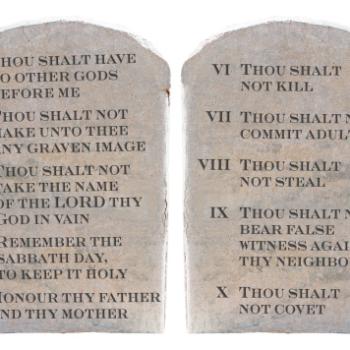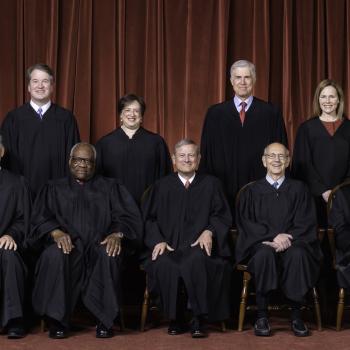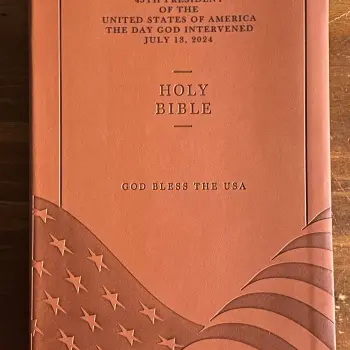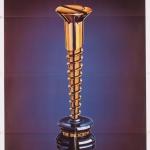Karen L. King is a distinguished professor at Harvard Divinity School who specializes in the study of early Christianity and Gnosticism. Two of the books she has authored are entitled The Gospel of Mary Magdala. She claims Jesus was married to Mary Magdalene on the basis of a Gnostic Gospel of Mary discovered in Cairo, Egypt, in 1896. That gets Christians riled up because the New Testament gospels don’t say any such thing.
In September, 2012, Dr. Karen King delivered a paper at a gathering at the Vatican that was about a new discovery of a papyrus fragment, measuring 1.5″ high by 3″ wide, from an ancient Coptic (Egyptian) text. It has the words, “Jesus said to them, ‘My wife …” The next line says, “She will be able to be my disciple.” And two lines later it reads, “I dwell with her.” Ms. King concludes that the “wife” is probably Mary Magdalene. Nevertheless, if authentic, it is the only ancient text which purportedly says Jesus was married, and in this case Jesus said it himself.
Here we go again. Dan Brown claimed the same in his controversial, 2003, blockbuster-bestselling novel, The Da Vinci Code. To further advance this provocation to the gatekeepers of orthodox Christianity–which includes leaders of the Coptic Church, which claims to be the oldest church in the world being traced to the Ethiopian eunuch in Acts 8.25-40–Ms. King named the document from which this fragment supposedly originated “The Gospel of Jesus’ Wife.” She said the fragment was given to her by an anonymous person and is now in safe-keeping at Harvard University.
When Ms. King spoke, she directed her audience to view online images of this small fragment. The next day, scholars who attended her lecture had analyzed these images and began questioning the authenticity of the fragment. One week later, the Vatican newspaper denounced the fragment as a “fake.” As might be expected, Catholics criticized Ms. King for not telling Vatican authorities in advance what the fragment was about. Ms. King also reportedly told Smithsonian Magazine that the fragment casts doubt “on the whole Catholic claim of a celibate priesthood based on Jesus’ celibacy.”
Ms. King then had two radiometric tests done on the fragment. The results were that the papyrus plant from which it was produced was grown during the seventh to the ninth centuries CE. Carbon dating of the artifact placed its origin during the period between the fourth and eighth centuries CE. Papyri are thin, paper-like writing materials.
Debate then ensued in the academic community, especially in the U.S., as to whether this fragment was legitimate or a forgery. And the media sometimes highlighted this discussion.
A month ago, the Harvard Theological Review published several articles by scholars claiming that this Jesus’ Wife Fragment, as it was now called, was authentic. It’s online issue of these articles had links. One of them was to images of another fragment purporting to be from an ancient copy of the Gospel of John in the New Testament, also written in the same Coptic dialect, Lycopolitan, as that of the Jesus’ Wife Fragment. Many extant biblical manuscripts were written in Coptic during the early centuries of Christianity.
Only a few days ago, on April 24 this year, Dr. Christian Askeland, a Coptic specialist at Indiana Wesleyan University, announced on his blog that these images of a Gospel of John fragment have striking similarities to the Jesus’ Wife Fragment that make both very suspicious. He said minute analysis proves that both fragments were produced with the same handwriting, same ink, and same writing instrument. Accordingly, both writings were written by the same person. Moreover, both fragments were written in the same Coptic dialect, Lypopolitan, which fell into disuse during the sixth century CE or before. Thus, the papyrus of the Jesus’ Wife Fragment was produced after the Lycopolitan dialect was no longer being used. Moreover, Askeland says of the Gospel of John fragment that it is a clear forgery, being a copy of a 1924 publication in which both have the same line breaks.
The next day, on April 25, Dr. Mark Goodacre, a distinguished professor at Duke University and also a Coptic expert, announced concerning this Gospel of John fragment, “It is a fake, and this conclusion means that the Jesus’ Wife Fragment is a fake too.”
I doubt we’ve heard the end of this debate about whether or not this Jesus’ Wife Fragment is authentic. But right now, it looks as though the traditional view that Jesus was always celibate is vouchsafed again.












